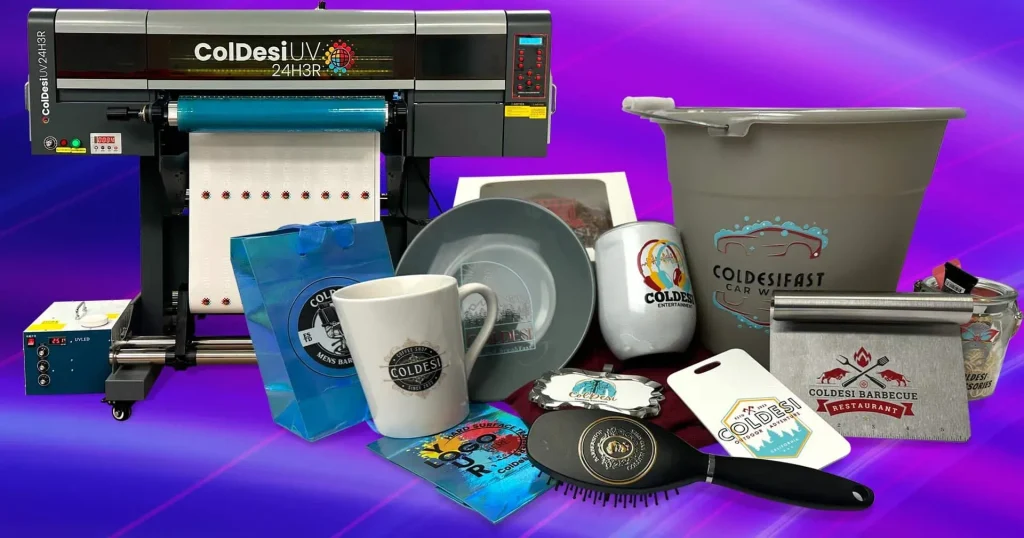In the evolving world of printing technology, **UV DTF printing** stands out as a revolutionary technique that combines the capabilities of ultraviolet (UV) printing with traditional direct-to-film (DTF) methods. This innovative approach allows for vibrant, high-quality prints with immediate adhesion, catering to a wide range of materials from textiles to metals. As businesses strive to stay ahead in the competitive printing market, UV DTF printing offers custom printing solutions that not only meet diverse client needs but also align with current eco-friendly printing trends. Additionally, the growing demand for personalized products is driving anticipated growth in this sector, making UV DTF an essential method for any forward-thinking printing operation. With these advancements, UV DTF printing is poised to redefine how industries approach their printing challenges.
Also known as ultraviolet direct-to-film printing, this cutting-edge process harnesses the power of UV printing technology to deliver unparalleled output quality. By instantly curing inks with UV light, this printing technique provides a level of detail and color vibrancy that traditional methods often struggle to achieve. As the printing landscape shifts towards embracing sustainable practices, UV DTF printing emerges as a frontrunner among eco-conscious printing solutions, allowing businesses to reduce their environmental footprint. Enhanced by its adaptability across various substrates, this modern printing method meets the rapidly changing demands of the market while also keeping pace with innovative design trends. In this guide, we will delve into the various facets of ultraviolet direct-to-film printing, exploring its advantages and potential applications.
Understanding the Basics of UV DTF Printing
UV DTF printing, or UV Direct-to-Film printing, introduces a fusion of traditional direct-to-film techniques with cutting-edge ultraviolet printing technology. This method utilizes UV light to instantly cure inks as they are applied to various substrates, allowing for immediate adhesion and bright colors. The result is high-definition prints that are not only visually stunning but also suitable for a myriad of applications, from apparel to promotional materials. As more companies embrace this technology, understanding its fundamental processes and advantages becomes crucial for those looking to optimize their production capabilities.
One of the standout features of UV DTF printing is its ability to elevate print quality through precise ink application and high-speed curing. The advanced UV LED printers used in this method are designed for efficiency, minimizing production times and ensuring cleaner finishes. Additionally, the versatility of the technology means it can be used on an array of substrates, including textiles, wood, glass, and metals. This versatility makes UV DTF printing an appealing option for businesses aiming to cater to diverse customer demands.
Advantages of UV DTF Printing Over Traditional Methods
The transition from traditional printing methods to UV DTF printing comes with numerous advantages. One of the most notable benefits is the reduced environmental impact associated with UV inks, which emit lower levels of volatile organic compounds (VOCs). As awareness of environmental sustainability grows, more businesses are seeking eco-friendly printing solutions that help them meet their environmental commitments while still achieving superior print quality. By adopting UV DTF printing, companies can effectively align their operations with modern sustainability goals.
Moreover, UV DTF printing provides remarkable protection to printed designs. The cured inks exhibit excellent resistance to fading, abrasion, and scratches, ensuring that the final products maintain their aesthetic appeal for longer durations. This durability not only enhances the lifespan of the printed items but also positions UV DTF printing as a cost-effective choice over time, giving businesses a competitive edge in a market increasingly driven by quality and longevity.
Key Markets and Applications for UV DTF Printing
UV DTF printing is rapidly gaining traction across various industries, primarily due to its adaptability in producing high-quality, customized products. Sectors such as fashion, home decor, and promotional items are increasingly utilizing UV DTF technology for its versatility. This printing method allows businesses to create intricate designs on diverse materials, making it ideal for producing everything from personalized apparel to branded merchandise. As the demand for tailored products continues to rise, UV DTF printing is well-positioned to meet these evolving consumer preferences.
The capacity for UV DTF printing to create unique and vibrant prints also caters well to niche markets, such as custom signage and decorative objects. Companies can leverage this technology to produce stunning graphics that command attention, enhancing their branding and visual presence in the marketplace. As more industries recognize the benefits of UV DTF printing, the technology is anticipated to flourish, leading to a wider adoption of custom printing solutions that meet specific consumer needs.
Future Trends in UV Printing Technology
As the UV printing market evolves, several emerging trends appear to shape the future of UV DTF printing. One notable trend is the continuous advancement in printing technology, which is driving improvements in speed, efficiency, and overall output quality. New printer models are being released with features designed to enhance color accuracy and streamline the printing process. This evolution is crucial for businesses as they strive to meet the growing consumer demands for high-quality, customizable items.
Furthermore, a strong emphasis on automation and digital solutions is expected to enhance user experiences related to UV DTF printing. Businesses of all sizes can benefit from simplified operations through user-friendly interfaces and automated workflows, which can significantly reduce human error and increase productivity. By integrating these innovations, companies can capitalize on the strengths of UV DTF technology, ultimately positioning themselves for success in a competitive printing landscape.
Challenges and Considerations in UV DTF Printing
While UV DTF printing carries significant advantages, it also presents certain challenges that businesses must navigate. One of the initial hurdles is the investment cost associated with acquiring UV printing equipment, which can be higher than traditional printing methods. For smaller businesses or startups, this investment may pose a financial barrier, necessitating careful consideration of budget allocations and potential return on investment.
Additionally, handling UV inks requires specialized training to mitigate issues like improper curing and color inaccuracies. Educating staff on best practices is essential for maximizing the quality of output and maintaining operational efficiency. Businesses aiming to implement UV DTF printing must ensure they establish robust training programs to equip their teams with the necessary skills to operate advanced printing systems effectively.
Frequently Asked Questions
What are the main advantages of UV DTF printing over traditional printing methods?
UV DTF printing offers several advantages over traditional methods, including faster curing times due to UV light, high-definition prints with vibrant colors, adaptability to various substrates, and lower emissions of volatile organic compounds (VOCs), making it an eco-friendly printing solution.
How does UV DTF printing work in comparison to direct-to-film printing?
UV DTF printing uses ultraviolet light to instantly cure inks applied to a film, allowing for vibrant prints with immediate adhesion. In contrast, traditional direct-to-film printing relies on heat transfer, which may lead to longer production times and potential quality issues.
What types of materials can be used with UV DTF printing technology?
UV DTF printing is highly versatile and can be used on a wide range of materials, including textiles, glass, wood, and metal, which allows businesses to explore various applications in fashion, home decor, and promotional items.
Is UV DTF printing a sustainable printing solution?
Yes, UV DTF printing is considered a more sustainable option due to its lower emissions of VOCs compared to conventional printing methods, making it an attractive choice for eco-conscious companies seeking to minimize their environmental impact.
What are the market trends related to UV printing technology in 2023?
In 2023, the UV printing market is witnessing significant growth, particularly in custom printing solutions. Increasing consumer demand for personalized products is driving innovation in UV DTF printing technology, with new models emphasizing ease of use and high-quality output.
What challenges do businesses face when adopting UV DTF printing?
Businesses may encounter challenges such as the initial investment in UV printing equipment, which can be higher than traditional methods, and the need for operator training to handle UV inks properly and ensure correct curing and color accuracy.
| Key Points | Description |
|---|---|
| What is UV DTF Printing? | A technique that uses UV light to cure inks on film, enabling immediate adhesion and vibrant colors, suitable for varied applications. |
| Key Components | 1. Printing Technology: Utilizes advanced UV LED printers for instant curing and cleaner finishes. 2. Adhesion: Bonds with a wide range of substrates including textiles, glass, wood, and metal. 3. Ink Type: Uses eco-friendly UV inks with lower VOC emissions. |
| Benefits of UV DTF Printing | 1. Versatile Applications across industries like fashion and decor. 2. Reduced Environmental Impact via lower VOC emissions. 3. Durability and Quality with resistance to abrasion and fading. |
| Market Trends | Growing demand for custom printing solutions and innovations in UV DTF printing equipment, focusing on user-friendliness and enhanced quality. |
| Challenges | Higher initial investment compared to traditional printing methods and the need for training in handling UV inks for proper application. |
| Future Innovations | Anticipated advancements in processes and user experience, leading to unique product offerings in the UV DTF printing market. |
Summary
UV DTF printing is transforming the landscape of the printing industry by providing innovative solutions that emphasize quality and sustainability. With its capacity for high-definition prints on a diverse array of materials, businesses are finding UV DTF printing not only versatile but also a key player in reducing environmental impact through lower emissions. The commitment to durability and the ability to cater to both large-scale and niche markets signals a promising future for UV DTF printing. As companies recognize the benefits of this technology, including its adaptability and quality assurance, it is set to become the preferred choice for customized products, thereby ensuring a competitive edge in a rapidly evolving market.



